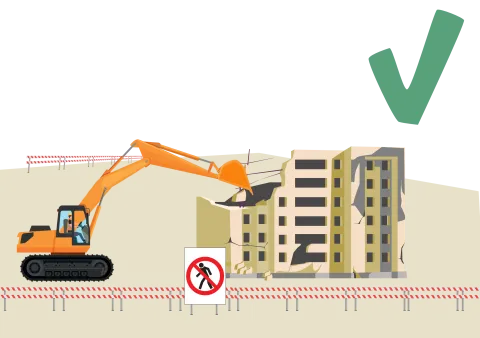
What risks can arise during demolition work on a construction site?
Demolition work on a construction site is among the very risky activities, with the danger of people being buried by demolished parts. Any removal of a part of the structure can affect the statics of the building, which then behaves unpredictably. Failure to follow the technological procedure, or its poor design, carries a great risk. Caution should also be maintained when combining manual and machine demolition. The key is to determine the appropriate technological procedure based on a detailed inspection of the structure. The demolition site must be secured against entry of unauthorized persons. The technological procedure must be established in such a way as to not compromise the stability of other parts of the structure. All utilities (water, electricity, gas) that are part of the demolished structure must be disconnected. Enclosed containers and spaces where hazardous substances were stored need to be ventilated Once the statics of the structure are compromised, it is no longer safe to enter, and it is also dangerous to even move in its vicinity. Therefore, the demolition must be carried out in parts and constantly checked whether the requirements set in the technological procedure are met.
The following happened: occupational injury of a foreigner during demolition work with fatal consequences
Two workers were demolishing a corner brick wall on the first floor of a company building with electric demolition hammers, each from one side. The wall was subsequently supposed to collapse controllably towards the interior of the building, but instead, the demolished structure collapsed outwards, resulting in the burial and death of a fifty-year-old worker from Ukraine.
What measures must the contractor take before commencing demolition work?
- Demolition work, where load-bearing elements of the building structure are affected, must be carried out only according to the technological procedure established in the documentation of demolition work.
- During demolition work for which the documentation of demolition work is not prepared, ensure the preparation of a technological procedure based on the survey of the condition of the structure in terms of its statics, materials used, technical equipment, utilities and wiring, condition of affected neighboring buildings, etc.
- Fill in or otherwise secure underground spaces discovered by the survey (e.g., cavities, wells, other underground structures). If it is not possible to disconnect internal utilities and installations for operational reasons in a renovated building, the contractor shall establish measures to ensure its safe operation during the demolition work.
- Disconnect and prevent use of internal utilities and installations embedded in the demolished structure.
- Set up a temporary electrical device that meets the standard requirements to ensure the supply of electrical energy for carrying out demolition work. Secure this device against damage, as well as the temporary water supply for sprinkling.
- Establish a signal for immediate evacuation of the workplace. The signal is given by a person designated by the contractor to manage the demolition work in case of urgent danger. This signal must be made known to all persons concerned.
- Define the danger zone and secure it against entry of unauthorized natural persons. Safely secure entries to the demolished structure and to individual workplaces and take necessary measures to protect the public interest, which may be endangered by these works. Obrázek

- Permanent supervision is carried out by a natural person authorized to do so by the contractor during:
- demolition of structures higher than ground level,
- pulling down vertical structures from a height of 3 m,
- demolition of staircases and protruding parts,
- demolition resulting in changes to the structural safety of the building
- machine demolition,
- demolition by a specific method (oxygen cutting),
- if demolition work is carried out at two or more places within the same structure being demolished simultaneously.
- The person authorized for permanent supervision must monitor the designated workplace, the execution of work, and the movement of natural persons on it throughout the duration of the permanent supervision, must not leave this workplace and not perform any activity other than supervision.
- Demolition work may only be commenced on the basis of a written order from a managerial employee and if the workplace has been equipped with auxiliary structures, materials and aids specified in the technological procedure.
"Ten Commandments" of safety during demolition work
- Demolition must be carried out in such a way that it does not compromise the stability of surrounding structures, or the neighboring structures must be secured in a manner specified in the documentation.
- Pulling down roof structures or trusses using ropes and pulling machines is only allowed if measures have been taken to stabilize the remaining part of the structure.
Demolition of arches by releasing part of the structure that secures them can only be carried out mechanically and if it is ensured that the collapse of the arch will not endanger natural persons.
Obrázek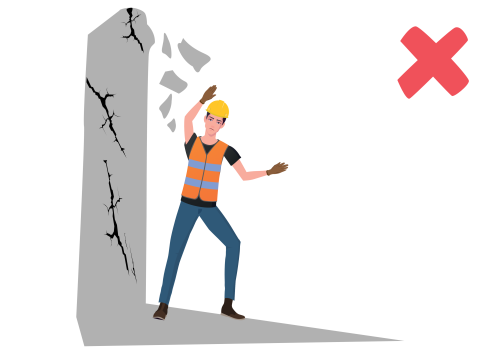
- If the load-bearing capacity of the structure being demolished is not ensured, demolition must be carried out from a separate auxiliary structure.
- When demolishing walls that stabilize protruding structures, such as balconies or bay windows, these structures must be secured to prevent undesirable loss of their stability.
- Structural elements may be removed during manual demolition only if they are not under load.
Manual demolition of load-bearing vertical structures must be carried out strictly from top to bottom, in such a way as to avoid the creation of overhangs.
Obrázek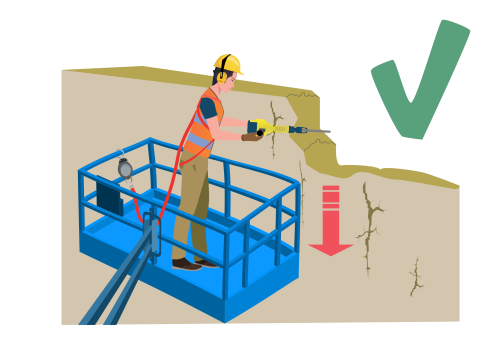
- Manual demolition of ceilings with a load-bearing structure is permitted only when the walls above it have been demolished, the load-bearing elements are exposed, and the demolished material has been removed from the ceilings.
Remove the demolished material in such a way as to avoid overloading the floors.
Obrázek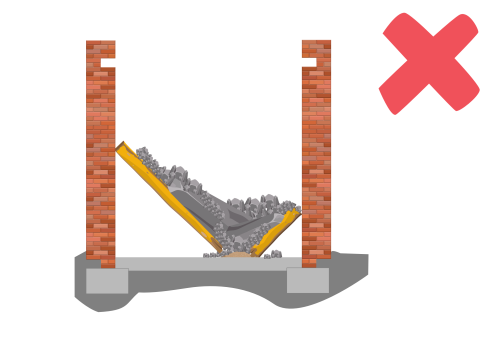
- Demolition work overhead is prohibited unless conditions for worker safety are specified in the technological procedure!
Beware of the danger of breakers and rotary hammers coming into contact with hidden power lines or gas lines that have not been disconnected! Check the site with a metal detector before starting the demolition.
Obrázek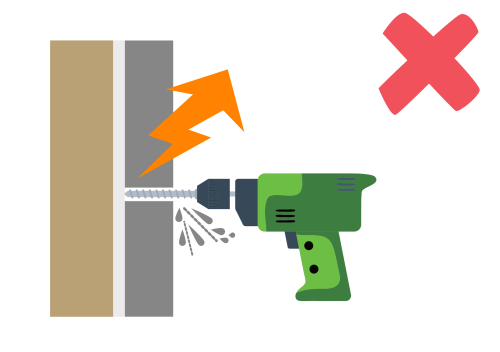
- Demolition must not be interrupted, unless the stability of the structure or part of it being demolished is ensured.
- Gradual demolition of buildings built with panel technology may be carried out only after the individual panels have been disconnected and their stability has been ensured.
- Beware of asbestos in buildings being demolished! When removing asbestos, the danger zone must be defined by a controlled zone. Eating, drinking and smoking are prohibited in the controlled zone. Demolished material containing asbestos must be handled as hazardous waste. Detailed conditions for working with asbestos are set, see Risk factors / 5.7 Asbestos.
More detailed safety requirements for demolition work can be found here:
Annex No. 3 XII to Government Regulation No. 591/2006 Coll., on more specific minimum requirements for occupational safety and health on construction sites